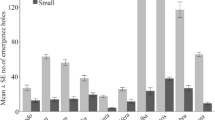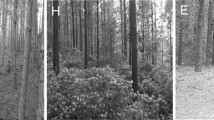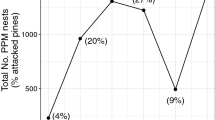Abstract
Effects of the periodical cicada (Magicicada spp.) on forest dynamics are poorly documented. A 1998 emergence of M. cassini in eastern Kansas led to colonization of a fragmented experimental landscape undergoing secondary succession. We hypothesized that per-tree rates of oviposition damage by cicadas would reflect: (1) distance from the source of the emergence, (2) patch size, and (3) local tree density. Ovipositing females displayed clear preferences for host species and damage incidence showed predictable spatial patterns. Two species (smooth sumac, Rhus glabra, and eastern red cedar, Juniperus virginiana) were rarely attacked, whereas others (rough-leaved dogwood, Cornus drummondii; slippery elm, Ulmus rubra; box elder, Acer negundo, and honey locust, Gleditsia triacanthos) were strongly attacked. The dominant early successional tree, dogwood, received on average the most attacks. As predicted, attacks per stem declined strongly with distance from the emergence source, and with local stem density (a "dilution" effect). Contrary to expectations, there were more attacks per stem on larger patches. Because ovipositing cicadas cut damaging slits in host tree branches, potentially affecting tree growth rate, competitive ability, and capacity to reproduce, cicada damage could potentially influence spatial variation in secondary succession.
Similar content being viewed by others
Author information
Authors and Affiliations
Additional information
Electronic Publication
Rights and permissions
About this article
Cite this article
Cook, W., Holt, R. & Yao, J. Spatial variability in oviposition damage by periodical cicadas in a fragmented landscape. Oecologia 127, 51–61 (2001). https://doi.org/10.1007/s004420000559
Received:
Accepted:
Published:
Issue Date:
DOI: https://doi.org/10.1007/s004420000559




